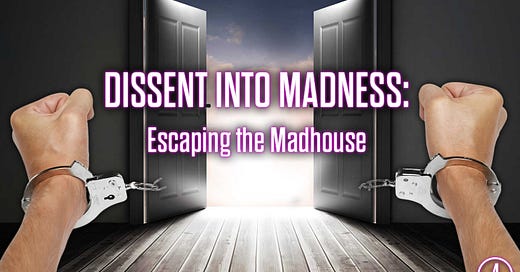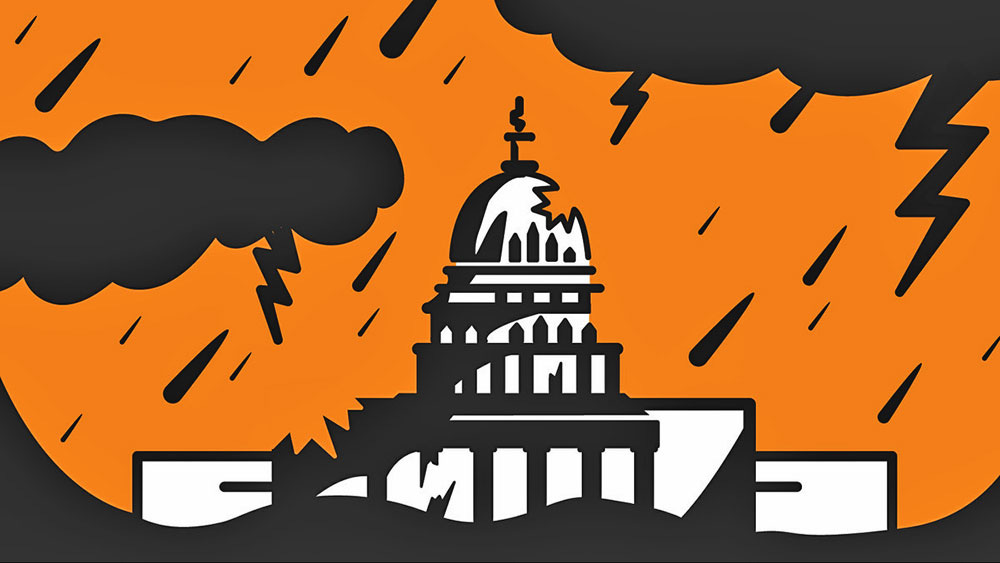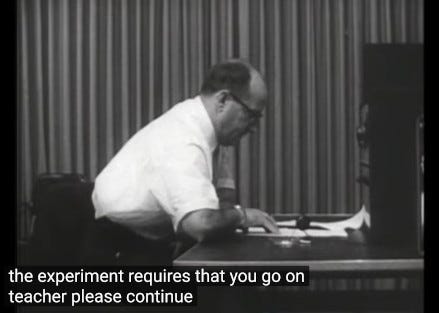by James Corbett
corbettreport.com
April 16, 2023
In the "Dissent Into Madness" series, we have been exploring the nexus of psychology and politics.
In Part 1 of this series, "The Weaponization of Psychology," I detailed the process by which the psychiatric profession has been turned into an instrument for repressing and marginalizing political dissidents.
In Part 2, "Crazy Conspiracy Theorists," I documented how this weaponized psychology has been wielded against conspiracy theorists, pathologizing those who seek to point out the obvious truths about world events such as 9/11 and the scamdemic.
In Part 3, "Projections of the Psychopaths," I documented the psychopathology of those in positions of political power and noted how society itself is being warped to reflect those psychopaths' own twisted psyche.
Finally, in this week's conclusion to the series, I will tackle the most important question of all: how do we escape the madhouse constructed by the political psychopaths?
Pathocracy
Statist propaganda in the West tries to convince us that we live in a democracy, exemplifying Abraham Lincoln's famous ideal of "government of the people, by the people, for the people."
But this is gaslighting. In truth, we live in a pathocracy, which, borrowing from Lincoln, might be described as "government of the psychopaths, by the psychopaths, for the psychopaths."
Although "pathocracy" is still a foreign concept to many, it is by now a well-established and thoroughly documented phenomenon. The term was coined by Andrew Lobaczewski—a Polish psychologist whose life's work was shaped by his experience growing up first under the thumb of the brutal Nazi occupation and then under the equally brutal Soviet regime—in his book, Political Ponerology.
Lobaczewski defines pathocracy as a system of government "wherein a small pathological minority takes control over a society of normal people." Then, in a chapter of Political Ponerology devoted to the subject, he describes how pathocracies develop, how they consolidate power, and how they trick, cajole, intimidate and otherwise induce non-psychopaths into participating in their madness.
How can soldiers' natural aversion to pulling the trigger on complete strangers be overcome? How can doctors who have sworn an oath to do no harm participate in the scamdemic madness of recent years? How can regular, salt-of-the-earth, working-class policemen be induced to brutally beat peaceful protesters? These are the questions that keep both the pathocrats in power and those looking to escape the pathocracy up at night, albeit for very different reasons.
Thankfully, we do not need to ponder these questions in a vacuum. In fact, the conditions for creating an environment in which the average person can be induced to participate in evil acts has been studied, catalogued and discussed by psychologists for the better part of a century. Unsurprisingly, though, this research, ostensibly intended to better understand how people can guard against such manipulation, has instead been weaponized by the pathocrats and used to fine-tune the creation of systems for generating more obedient order-followers. In fact, this was part of the point of the well-known but almost completely misunderstood Milgram experiments (more on which below).
At this point in our exploration, we are finally beginning to grasp the full extent of the problem posed by psychopaths in positions of political, corporate and financial power.
The problem isn't just that psychology has been weaponized against those of us who would engage in political dissent.
And the problem isn't simply that this system for suppressing and pathologizing dissent has been created by literal psychopaths and their sociopathic lackeys.
The problem is that the state itself is psychopathic and is actively warping the morals of otherwise mentally sound individuals, causing them to adopt psychopathic traits in return for material reward and positions of authority.
This is the problem of pathocracy.
Once we realize the gravity of this situation, the obvious question presents itself: how do we throw off the yoke of the political psychopaths and topple their pathocracy?
As usual, the quality of our answer to this question is directly dependent on the depth of our understanding of the underlying problem.
For example, in The Corbett Report comments section recently, Corbett Report member TruthSeeker framed the problem of toppling the pathocracy this way: "Perhaps we can find a way to eliminate psychopaths from all positions of power."
At first glance, this suggestion seems like a reasonable course of action. After all, if we could find a way to "eliminate psychopaths from all positions of power," then that would automatically solve the problem of political psychopathy, wouldn't it?
But, as Corbett Report member G. Jinping noted in his reply to TruthSeeker:
We'll have to come up with a solution (for getting psychopaths out of power) that takes into account that the number two man, number three, etc. are probably just psychopaths who are at an earlier stage in their ascent to the top. Maybe we could just pick names at random from the phone book, if we still had phone books! Seriously, this is an intractable problem, that can only be addressed with the decentralization of power. I don't expect that to happen anytime soon.
Indeed, as G. Jinping rightly observes, the problem is more pervasive than many are willing to believe.
TruthSeeker's proposal would be viable only if there are a few isolated psychopaths who happen to have ascended to positions of political power. But if there are in fact many psychopaths who are all vying with each other for political control, then we have to understand that eliminating the current political psychopaths would merely open the door for others to step into those vacant positions. Worse, given the psychopathic nature of the power structure as it exists, the system itself actually ensures that psychopaths and sociopaths who, by definition, show no remorse or moral qualms about hurting others will end up winning the vicious battle to fill the top spots in the political hierarchy.
Only when we step back and interrogate the political system as a whole can we appreciate that the very existence of those seats of power from which a handful of individuals can rule over the masses is itself a construct of the pathocracy. Unless and until those seats of power are eliminated altogether, we will never rid ourselves of the struggle for dominance that rewards the psychopaths with control over others.
The elimination of those seats of power, however, will not happen until we overturn the underlying assumption that centralization of power is necessary in the first place. And sadly, as G. Jinping correctly observes, given the relatively infantile state of humanity's political development, we should not expect the Ring of Power to be cast into the fires of Mount Doom anytime soon.
So, for those of us morally sound individuals currently living under the rule of the psychopaths, the question remains: what can we possibly do to overthrow the pathocracy?
As it turns out, the answer to that question may be much simpler than we think.
Circuit Breaker
In the 1960s, psychologist Stanley Milgram set out to study the extent to which people's blind obedience to perceived authority influences their behaviour. It was with this goal in mind that Milgram began his infamous study of obedience on August 7, 1961.
The results of those experiments, well-known to the public by now, ostensibly demonstrate that average, everyday people can be induced to deliver what they believe to be potentially lethal electric shocks to complete strangers based solely on the say-so of an authority figure. This finding is most commonly summarized with the factoid that a whopping 65% of participants in the original 40-person study were willing to deliver a 450 Volt shock—what they were led to believe could be a potentially lethal shock—to an audibly distressed person based on nothing more than a prompt from a person in a lab coat wielding a clipboard.
As one of the most famous psychological studies of the 20th century, the Milgram experiments have generated no end of debate, controversy and scrutiny. The NPR-promoted critics of the experiments, who contend that most of the study's participants knew that the entire situation was phoney and that they disobeyed even more often than was reported, are often pitted against the establishment psychologist defenders of the experiment, who correctly note that the experiments' shocking (pun intended) conclusions have been independently reproduced time and time and time again in country after country around the world. (In one particularly twisted reproduction, the researchers even sought to ensure that no subject would suspect the experiment was fake by delivering real electric shocks to cute puppies).
What almost everyone misses about the Milgram experiments, however, is that the study was not one experiment that was conducted on one set of 40 participants one time to yield one final result. In fact, Milgram conducted the experiment a total of 17 times with 17 separate cohorts of 40 to 60 test subjects, with each iteration of the study employing a number of experimental variations.
In one variation, he changed the site of the study from the Yale University campus to a rundown office building. In another variation, the test subjects were allowed to instruct an assistant to deliver the shocks instead of pressing the switch themselves. In still another variant, the lab coat-wearing actor playing the "experimenter" was called away on business and replaced by an ordinary man wearing a suit. And in yet another variation, the test subject was obliged to wait and watch another actors become the "teacher" and go through the experiment before assuming the role himself.
Each variation produced markedly different results. When the test subject could instruct someone else to deliver the shocks instead of doing it himself, for instance, the percentage of participants willing to deliver the maximum (supposedly potentially lethal) shock rose to an incredible 92.5%. When the experiment took place in an office building instead of on the Yale campus, the number willing to administer the maximum shock dropped to 48%. And when the test subject watched other people take the "teacher" role before them and observed them refusing to obey the experimenter's command to deliver the shocks, that subject's willingness to deliver the maximum shock plummeted to 10%.
Let me rephrase that for the hard of thinking. When the test subject saw someone disobey the experimenter, they themselves refused to proceed with the experiment 90% of the time.
This is the surprising conclusion that has been scrubbed from most accounts of the Milgram experiments: Disobedience, once modeled, becomes an option in the mind of the public.
This point is crucial to understand because, exactly as Étienne de La Boétie pointed out nearly 500 years ago, a small cadre of tyrants, no matter how psychopathically menacing, are incapable of administering a tyranny all by themselves. They require the active participation of a much larger number of obedient order-followers.
Indeed, it is important to become conscious of the fact that none of the worst excesses of the pathocracy in recent times would have been possible without the active participation of vast swaths of the population. So-called vaccine "mandates" were not achieved by one psychopath in a position of political authority, or even by a gaggle of such pathocrats. They were enabled by the doctors who participated in the vaccination drives against their own experience, judgment and training, the employers who imposed vaccine requirements on their employees, the business owners who implemented vaccine certificate checks on their premises, the police officers who threw the unvaccinated in quarantine facilities, the workers who kept those quarantine centers functioning, the judges and lawyers who rubber-stamped all these actions, etc.
The same goes for any number of pathocratic abuses that we have been subjected to in recent years. These programs can only be implemented when most of the people comply with their orders and thus fulfill their role in the operation.
Just as in the time of La Boétie, our enslavement to the pathocracy is, by and large, a voluntary servitude born of obedience.
Combining La Boétie's insight with Milgram's lesser-known experimental results, then, we find a template for toppling the pathocracy: highly visible acts of disobedience.
But is this true? Can a single act of disobedience really bring down a pathocracy?
Once again, we don't have to speculate about this possibility in a vacuum. Thanks to the wonders of modern technology, we can actually watch a recording of such an event happening in real time.
On December 21, 1989, Romanian dictator Nicolae Ceaușescu took to Palace Square to address the Romanian people. At first, it proceeded like any number of such speeches he had delivered over the years. He talked about the successes of Romania's socialist revolution and sung the praises of the "multi-laterally developed Socialist society" that had arisen under his brutal reign.
But then, something extraordinary happened. Someone booed. The boo was taken up by others and became a jeer. Chants of "Timișoara!" rippled through the crowd, a reference to a massacre of political dissidents by Ceaușescu's security forces that had taken place just days earlier.
The dictator, unused to any sign of dissent from the population over whom he had ruled so brutally for decades, called for order. His wife demanded the crowd's silence, prompting Ceaușescu to tell her to shut up, and then he attempted to continue with his speech. But the jeers began again.
The footage of the incident, including Ceaușescu's look of utter confusion as he realizes that the crowd has turned against him and that the threat of violence is not enough to subdue them, is priceless. There, captured on tape for posterity, is the moment when the realization dawns on the tyrant that the people have rejected his tyranny. The rest of the story—the riots and unrest, the attempted escape of Ceaușescu and his wife, their capture by military defectors and their execution on Christmas Day—all stems from that precise moment when one person in the crowd simply voiced what the rest of the crowd was feeling.
This is the circuit breaker effect. By saying no to illegitimate authority, resisting bullies and tyrants, disobeying immoral orders, refusing to comply with unjust mandates and demands, we make it that much easier for those around us to stand up for what they, too, know to be right.
But wait, it gets even better . . .
Escaping the Madhouse
First, the good news: pathocracies are inherently unstable and they are doomed at some point to topple under their own weight.
Indeed, as Lobaczewski points out in his discussion of the phenomenon, pathocracies by their very nature possess numerous weaknesses that make their downfall inevitable. They require, for instance, that key administrative positions be filled not by finding the most competent men and women in the general public and promoting them based on ability and merit, but by recruiting the most serviceable lackeys from the much narrower pool of psychopaths and sociopaths. This leads to the seemingly endless parade of low-grade morons and feckless, out-of-touch imbeciles who end up in positions of power, greatly degrading the effectiveness and stability of the pathocratic state.
Pathocrats, like all psychopaths, also live in mortal fear of being exposed as pathological. Commenters on psychopathy have long pointed out that the mask of sanity—the psychopath's ability to hide their moral defect from others—is incredibly important to them. After all, once identified, psychopaths can be effectively shunned and "eliminated" from positions of power, as TruthSeeker suggests above. As Lobaczewski writes:
Normal people slowly learn to perceive the weak spots of such a system and utilize the possibilities of more expedient arrangement of their lives. They begin to give each other advice in these matters, thus slowly regenerating the feelings of social links and reciprocal trust. A new phenomenon occurs: separation between the pathocrats and the society of normal people. The latter have an advantage of talent, professional skills, and healthy common sense.
Next, the even better news: if it is true that psychopaths can fashion a psychopathic society that twists people into sociopthats, then the opposite is true, too. Healthy, non-pathological humans with love, empathy and compassion can fashion a society that brings out the better side of human nature.
This is the real goal of the erstwhile victims of the pathocrats. Not to eliminate the political psychopaths and assume their positions of power in the psychopathic political system that they created, nor even to abolish that system altogether, but to envision a world in which compassion, cooperation, love and empathy are not just encouraged but actively rewarded. A world in which every person is allowed to become their best possible self.
It is up to each one of us to model that which we wish to see in the world. Just like the brave dissenter who can break the circuit of tyranny by voicing opposition to the tyrant, we can also become the models of love, understanding and compassion that will motivate others to become the same.
After all, if the psychopaths have spent centuries weaponizing psychology to more effectively control us, can't we wield our understanding of human nature for something good? And isn't that what healthy, non-psychopathic individuals forming a healthy, non-psychopathic society would spend their time and resources doing?







